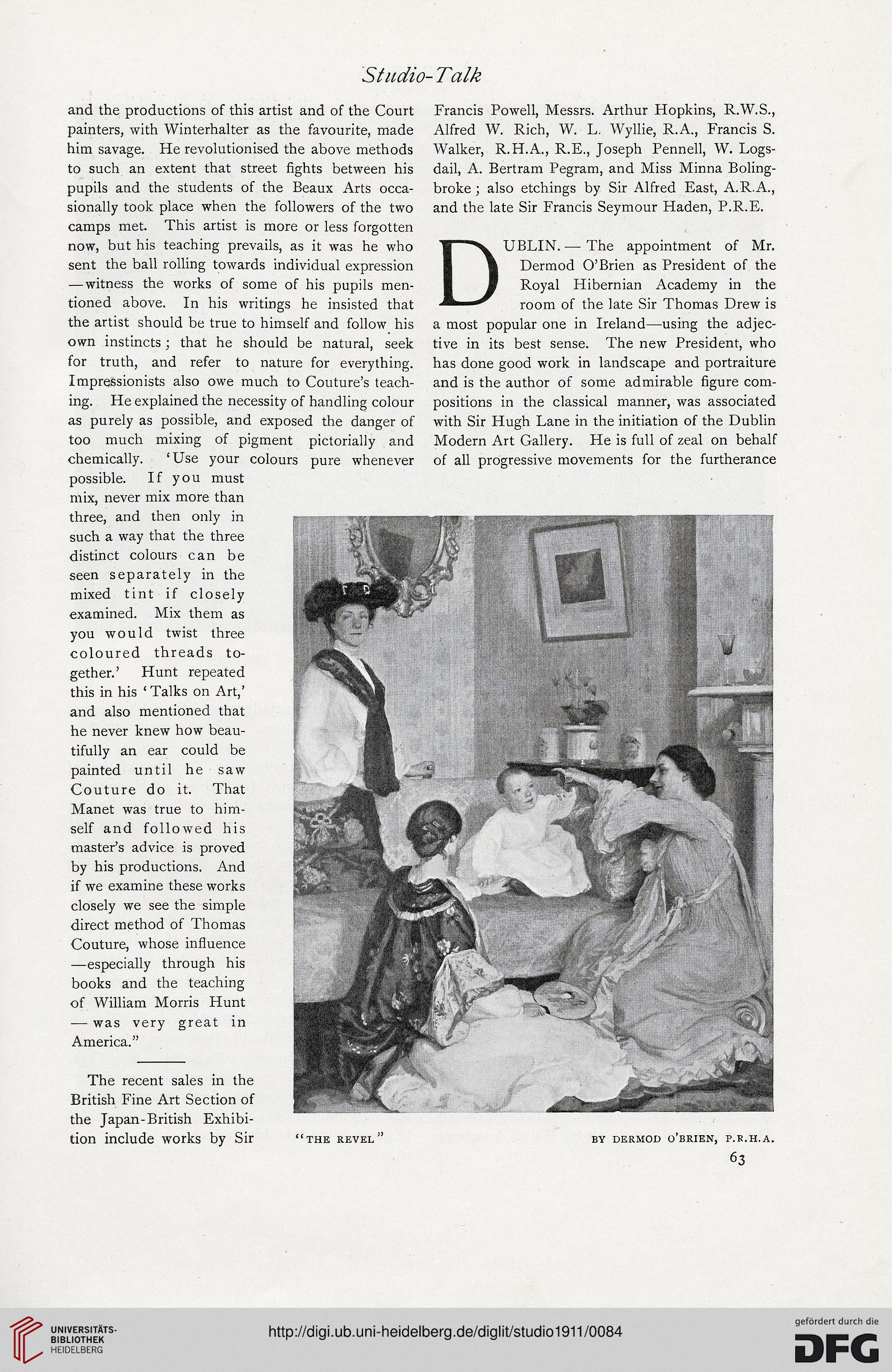Studio-Talk
and the productions of this artist and of the Court
painters, with Winterhalter as the favourite, made
him savage. He revolutionised the above methods
to such an extent that street fights between his
pupils and the students of the Beaux Arts occa-
sionally took place when the followers of the two
camps met. This artist is more or less forgotten
now, but his teaching prevails, as it was he who
sent the ball rolling towards individual expression
—witness the works of some of his pupils men-
tioned above. In his writings he insisted that
the artist should be true to himself and follow his
own instincts; that he should be natural, seek
for truth, and refer to nature for everything.
Impressionists also owe much to Couture’s teach-
ing. He explained the necessity of handling colour
as purely as possible, and exposed the danger of
too much mixing of pigment pictorially and
chemically. ‘Use your colours pure whenever
possible. If you must
mix, never mix more than
three, and then only in
such a way that the three
distinct colours can be
seen separately in the
mixed tint if closely
examined. Mix them as
you would twist three
coloured threads to-
gether.’ Hunt repeated
this in his ‘Talks on Art,’
and also mentioned that
he never knew how beau-
tifully an ear could be
painted until he saw
Couture do it. That
Manet was true to him-
self and foil owed his
master’s advice is proved
by his productions. And
if we examine these works
closely we see the simple
direct method of Thomas
Couture, whose influence
—especially through his
books and the teaching
of William Morris Hunt
— was very great in
America.”
Francis Powell, Messrs. Arthur Hopkins, R.W.S.,
Alfred W. Rich, W. L. Wyllie, R.A., Francis S.
Walker, R.H.A., R.E., Joseph Pennell, W. Logs-
dail, A. Bertram Pegram, and Miss Minna Boling-
broke ; also etchings by Sir Alfred East, A.R.A.,
and the late Sir Francis Seymour Haden, P.R.E.
DUBLIN.— The appointment of Mr.
Dermod O’Brien as President of the
Royal Hibernian Academy in the
room of the late Sir Thomas Drew is
a most popular one in Ireland—using the adjec-
tive in its best sense. The new President, who
has done good work in landscape and portraiture
and is the author of some admirable figure com-
positions in the classical manner, was associated
with Sir Hugh Lane in the initiation of the Dublin
Modern Art Gallery. He is full of zeal on behalf
of all progressive movements for the furtherance
The recent sales in the
British Fine Art Section of
the Japan-British Exhibi-
tion include works by Sir
‘THE REVEL
BY DERMOD OBRIEN, P.R.H.A.
63
and the productions of this artist and of the Court
painters, with Winterhalter as the favourite, made
him savage. He revolutionised the above methods
to such an extent that street fights between his
pupils and the students of the Beaux Arts occa-
sionally took place when the followers of the two
camps met. This artist is more or less forgotten
now, but his teaching prevails, as it was he who
sent the ball rolling towards individual expression
—witness the works of some of his pupils men-
tioned above. In his writings he insisted that
the artist should be true to himself and follow his
own instincts; that he should be natural, seek
for truth, and refer to nature for everything.
Impressionists also owe much to Couture’s teach-
ing. He explained the necessity of handling colour
as purely as possible, and exposed the danger of
too much mixing of pigment pictorially and
chemically. ‘Use your colours pure whenever
possible. If you must
mix, never mix more than
three, and then only in
such a way that the three
distinct colours can be
seen separately in the
mixed tint if closely
examined. Mix them as
you would twist three
coloured threads to-
gether.’ Hunt repeated
this in his ‘Talks on Art,’
and also mentioned that
he never knew how beau-
tifully an ear could be
painted until he saw
Couture do it. That
Manet was true to him-
self and foil owed his
master’s advice is proved
by his productions. And
if we examine these works
closely we see the simple
direct method of Thomas
Couture, whose influence
—especially through his
books and the teaching
of William Morris Hunt
— was very great in
America.”
Francis Powell, Messrs. Arthur Hopkins, R.W.S.,
Alfred W. Rich, W. L. Wyllie, R.A., Francis S.
Walker, R.H.A., R.E., Joseph Pennell, W. Logs-
dail, A. Bertram Pegram, and Miss Minna Boling-
broke ; also etchings by Sir Alfred East, A.R.A.,
and the late Sir Francis Seymour Haden, P.R.E.
DUBLIN.— The appointment of Mr.
Dermod O’Brien as President of the
Royal Hibernian Academy in the
room of the late Sir Thomas Drew is
a most popular one in Ireland—using the adjec-
tive in its best sense. The new President, who
has done good work in landscape and portraiture
and is the author of some admirable figure com-
positions in the classical manner, was associated
with Sir Hugh Lane in the initiation of the Dublin
Modern Art Gallery. He is full of zeal on behalf
of all progressive movements for the furtherance
The recent sales in the
British Fine Art Section of
the Japan-British Exhibi-
tion include works by Sir
‘THE REVEL
BY DERMOD OBRIEN, P.R.H.A.
63




